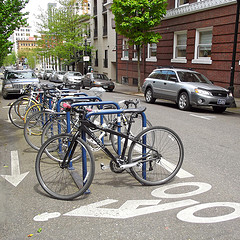Expanding Bike Programs
A Modest Proposal in a Time of Shrinking Budgets, Soaring Gas Prices
by Jay Walljasper
Gas prices have raced toward four bucks for the second time in three years. So it’s more crucial than ever to find quick, enduring ways to free our nation from over-dependence on oil.
 Millions of Americans suffer when prices at the pump rise, because they have no alternative to driving almost everywhere they go. We need to create a transportation system that will not be held hostage by volatile fuel prices.
Millions of Americans suffer when prices at the pump rise, because they have no alternative to driving almost everywhere they go. We need to create a transportation system that will not be held hostage by volatile fuel prices.
Here’s some good news: Over the past few years, simple infrastructure improvements (bike paths, lanes, etc) making it more convenient and safe for people to bike and walk have been constructed coast-to-coast. Cities from New York to Minneapolis to San Francisco have enjoyed 100 percent or more increases in the number of people biking to work, school, and shopping.
Smaller cities from Greenville, South Carolina, to North Little Rock, Arkansas to Long Beach, California are now following suit. Creating better conditions for biking and walking is one proven innovation to cushion us from the economic upheaval of high gas prices.
But here’s some troubling news: much of the talk around Washington and state capitals this year is about eliminating or slashing these successful programs. That’s penny-wise and dollar-dumb. Biking and walking comprise only 1.5 percent of the overall federal transportation budget, while they account for 12 percent of all trips made by Americans today.
Indeed, the entire price tag for more than 3,000 federally funded bike and pedestrian projects across 50 states last year amounted to less than half the cost of one highly contested highway project in Maryland that opened this spring.
Bicycling has boomed during the past 15 years, illustrating how a small amount of federal funding has leveraged big results throughout America. And this was achieved through “bike-partisan†consensus.
In 1991, President George H.W. Bush signed new a new transportation bill that for the first time in history included federal funding for improvements in bicycling, walking and other transportation “enhancements.” While that term sounds like frills, in reality the program paved the way for many cities, suburbs and small towns to establish biking and walking as viable transportation options. Bill Clinton and George W. Bush signed new transportation bills in 1998 and 2005 with increased funding for biking and walking.
The results have been striking. The number of biking and walking trips made by Americans increased 60 percent during the last decade. This includes commuters on their way to work, but also many other folks who sometimes leave the car behind on errands close to home. Half of all trips Americans take are three miles or less, which can be done on bike in less than 20 minutes.
Over 20 years, the number of bike commuters in Portland, Oregon, has increased five-fold to six percent (12 percent downtown) on a public investment of $57 million (about $3.50 per resident per year). Everyone benefits from fewer cars on the streets, reduced congestion and less need for costly road and parking projects.
Bike commuters in Minneapolis have almost tripled since 1993, with biking and walking now accounting for 20 percent of all trips around town. Seventy-five percent of children in Boulder, CO now bike or walk to school thanks the national Safe Routes to School Program, another part of the transportation funding.
Beyond economic benefits, bicycling and walking also boost environmental quality and public health — which translates to considerable costs savings in federal and state budgets for Medicare, Medicaid, and health care.
Two phrases heard frequently in political discussions these days are self-reliance and fiscal responsibility. So it’s surprising that some leaders in Congress and state legislatures want to scrap the accomplishments of George H.W. Bush, Bill Clinton, and George W. Bush by chopping bike and walk programs.
Biking and walking make far fewer demands on the public purse than driving, so it follows that government programs to boost the number of trips on foot and bike will be an important component of any cost-effective approach to transportation. A mile of new urban freeway costs $46-100 million, according to former House of Representative Transportation chairman Jim Oberstar, while a mile of 12-foot-wide bikeway costs $125,000.
With gas prices soaring, health care costs skyrocketing, political instability continuing across the Middle East, and more American families struggling to pay monthly bills, low-cost projects to help more people walk and bike offer a wise investment. In fact, Republicans and Democrats alike should support these policies as patriotic, fiscally responsible, and forward-looking.
Jay Walljasper is co-editor of OnTheCommons.org, and is the author of the new book All That We Share: A Field Guide to the Commons (The New Press, 2010). He is a Contributing Editor at National Geographic Traveler, a Senior Fellow of the Project for Public Spaces, and a Contributing Author for New Clear Vision.

The Houston area really needs to improve their public transportation. It’s good to see that a lot of other cities are seeing improvements. I do know that lots of Houstonians do choose to carpool which cuts down on expenses and emissions.
1